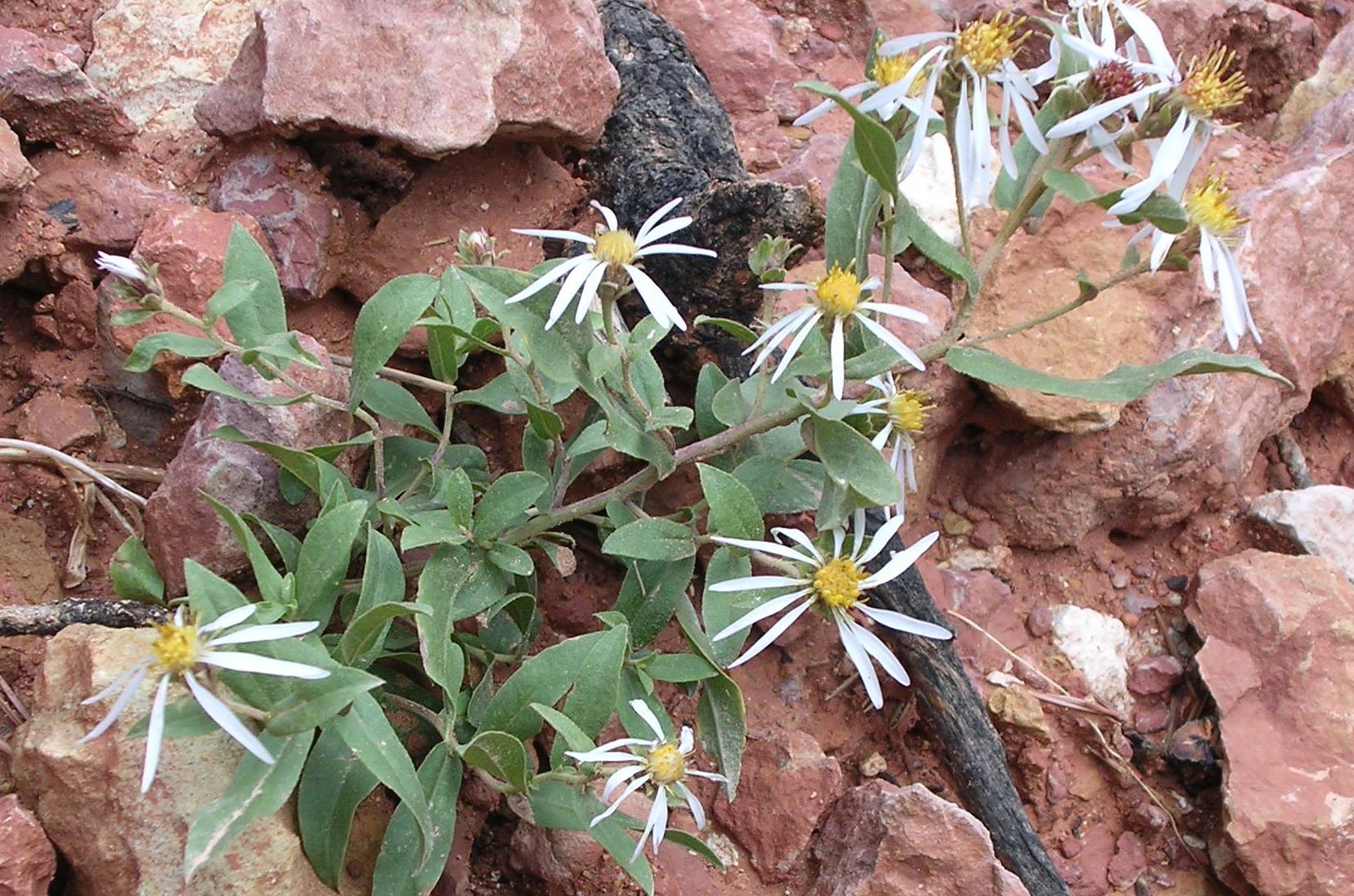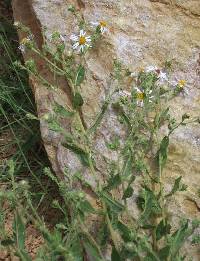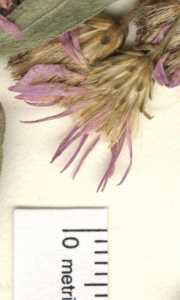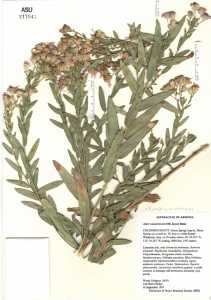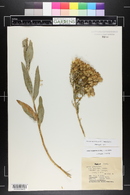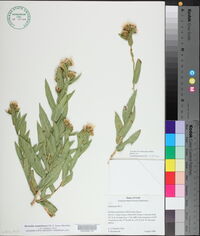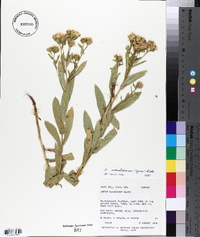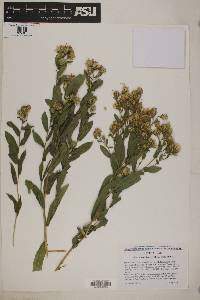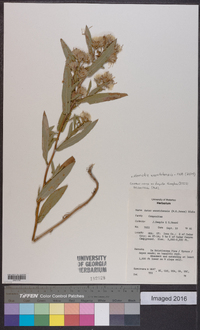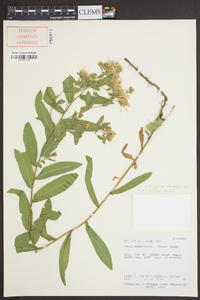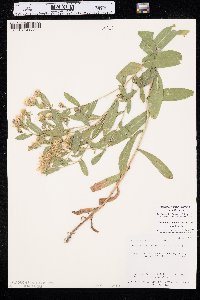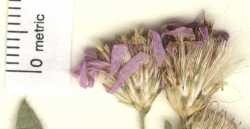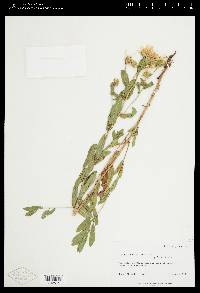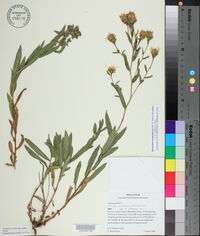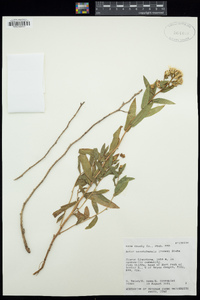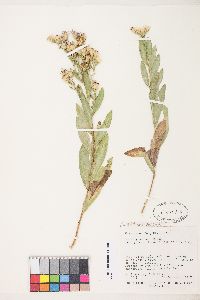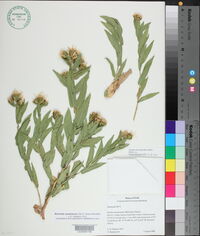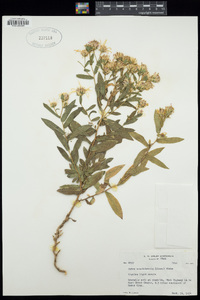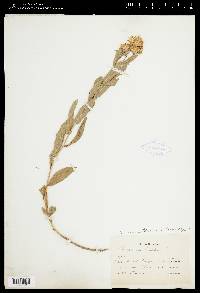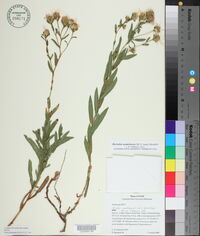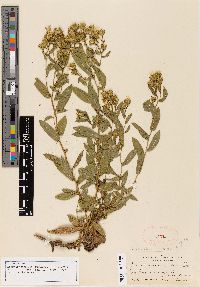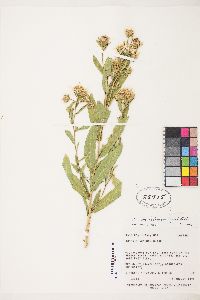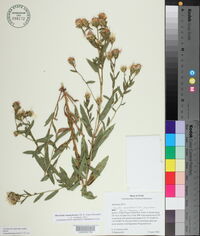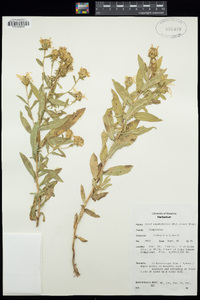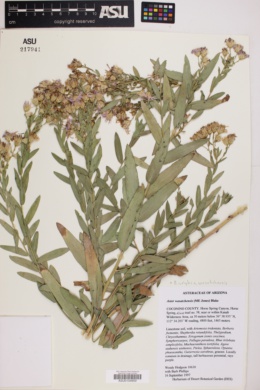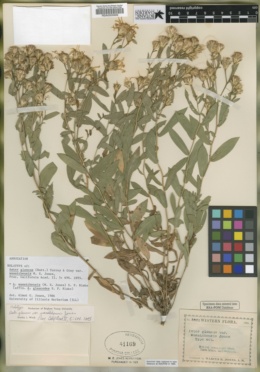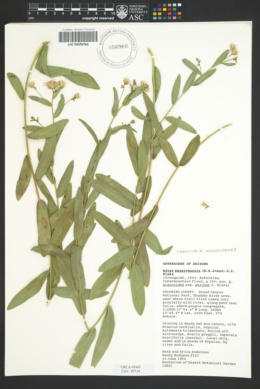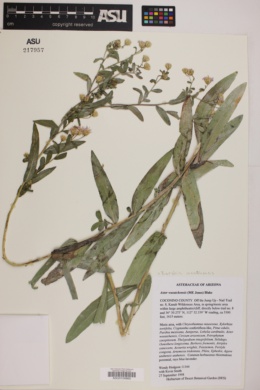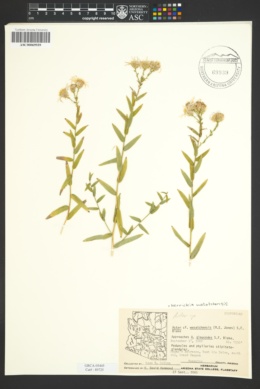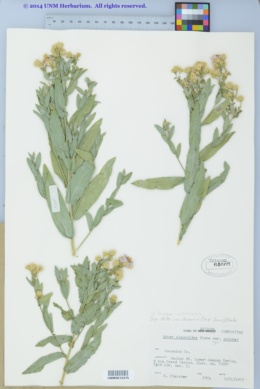
|
|
|
|
Family: Asteraceae
Wasatch aster
[Aster glauca var. wasatchensis (M.E. Jones) Blake, moreAster glaucus var. wasatchensis M.E.Jones, Aster wasatchensis S.F.Blake, Eurybia wasatchensis (M.E. Jones) G.L. Nesom] |
Non-technical Description:Wasatch aster is a perennial forb with clustered stems 30-80 cm tall from a freely-branched rootstalk. Leaves are numerous along the stem, with entire, sessile and clasping greenish (not bluish-green or glaucous) blades 5-10 cm long by 1-2.5 cm wide. The involucres, upper stems, and often the uppermost leaves are covered with short-stalked, sticky glands. Flower heads are borne in a broad, cyme-like corymb with green, somewhat spreading, obtuse involucre bracts 9-11 mm long. The white (rarely lavender) ray flowers number 13-21 and are 10-15 mm long. The disk is yellow and 8-15 mm wide. Fruits are sparsely hairy achenes topped by capillary bristles (Cronquist 1994, Fertig & Reynolds 2009, Welsh et al. 2008). Similar Species: Modest aster (Aster wasatchensis var. pulcher) has leaves that are bluish-green (glaucous) and appressed involucre bracts with a central green or purple stripe and scattered glands. Blueleaf aster (A. glaucodes) has glabrous, often bluish-tinged involucres with appressed, blunt tips and prominently glaucous leaves (Cronquist 1994). Habitat: Found on rocky slopes and alluvial terraces in pinyon-juniper, aspen, limber pine and spruce-fir communities in the mountains (Welsh et al. 2008). In Cedar Breaks National Monument, this species is found on steep, dry badlands all along the slopes of the Cedar Breaks Amphitheater. Populations are strongly correlated with exposures of barren orangish Claron limestone talus, rubble, and alluvium. Vegetative cover is typically low in occupied habitat (averaging 5-15%). The largest populations tend to occur on steep (up to 45°) exposed slopes of dry, reddish-orange Claron limestone talus with widely scattered Monardella odoratissima, Senecio atratus, Cirsium arizonicum, Eriogonum panguicense, and occasional Pinus longaeva and Cercocarpus ledifolius (Fertig & Reynolds 2009). References: Cronquist, A., A.H. Holmgren, N.H. Holmgren, J.L. Reveal, and P.K. Holmgren, eds. 1984. Volume 4, Subclass Asteridae (except Asteraceae). Intermountain Flora, Vascular Plants of the Intermountain West, U.S.A. New York Botanical Garden, Bronx, NY. 573 pp. Fertig, W. and D. N. Reynolds. 2009. Survey of rare plants of Cedar Breaks National Monument: Final Report. Welsh, S.L., N.D. Atwood, S. Goodrich, and L.C. Higgins. 2008. A Utah Flora, 2004-2008 summary monograph, fourth edition, revised. Brigham Young University, Provo, UT. 1019 pp. Author: Walter Fertig, Moenave Botanical Consulting, Kanab, UT. April 2017 Perennials, 20-60 cm, colonial and cespitose, short-stipitate-glandular; rhizomes woody, elongate and creeping, or short, erect, branched. Stems 1-4+, erect, sometimes branched proximally, straight glabrescent to thinly scabridulous proximally, stipitate-glandular distally, densely so in arrays. Leaves cauline, proximal smaller and withering by flowering, yellowish green, paler abaxially, firm; sessile; blades lanceolate (sometimes widely) or lanceolate-oblong to oblong or oblanceolate, 20-110 × 6-30 mm, bases ± clasping, rounded, main veins ± marked, margins entire, slightly indurate, sparsely to densely scabridulous, apices acute to obtuse, mucronate, faces glabrous; distal (arrays) lanceolate, 8-60 × 2-13 mm. Heads 2-20+ in ± open, corymbiform arrays with ascending branches. Peduncles densely stipitate-glandular; bracts 0-2, sometimes directly subtending heads, foliaceous or ± grading into phyllaries (bases scarious), margins glandular-ciliate, faces densely stipitate-glandular. Involucres campanulate, 8.5-11 mm. Phyllaries (27-31) in 3-4 series, keeled or rounded, ± spatulate to oblong-obovate or oblong (outer) to lanceolate or linear-lanceolate (inner), unequal, foliaceous (outermost) to membranous, green zones in distal 1 / 2 - 6 / 7 (outer) to ca. 1 / 10 or reduced to midnerve tips (inner), margins not (outer) or narrowly scarious, hyaline, sometimes purplish distally (inner), erose, glandular-ciliate, apices reflexed to squarrose, acute to acuminate, sometimes apiculate (innermost), abaxial faces ± stipitate-glandular (more densely so on green parts), adaxial stipitate-glandular (on green parts). Ray florets 13-21; laminae white (to pink), 15-28 × 1.6-2.5 mm. Disc florets 26-43; corollas yellow turning reddish purple, barely or not ampliate, 6.7-10.1 mm, tubes (2.2-3.6 mm) shorter than funnelform throats (3.8-5.4 mm), lobes erect to slightly spreading, lanceolate, 0.8-1.1 mm. Cypselae tan to brown or reddish brown, fusiform, ± compressed, 3.5-5.5 mm, ribs 9-10 (stramineous to tan), ± strigillose; pappi of (ca. 60) yellowish bristles 6.5-9.5 mm. 2n = 18. Flowering summer-early fall. Open, rocky slopes from foothills to mid elevations in mountains, pinyon-juniper, aspen, limber pine and spruce-fir communities; 1800-3050 m; Utah. Herrickia wasatchensis is known only from the Wasatch Mountains, where it is considered vulnerable.
|

